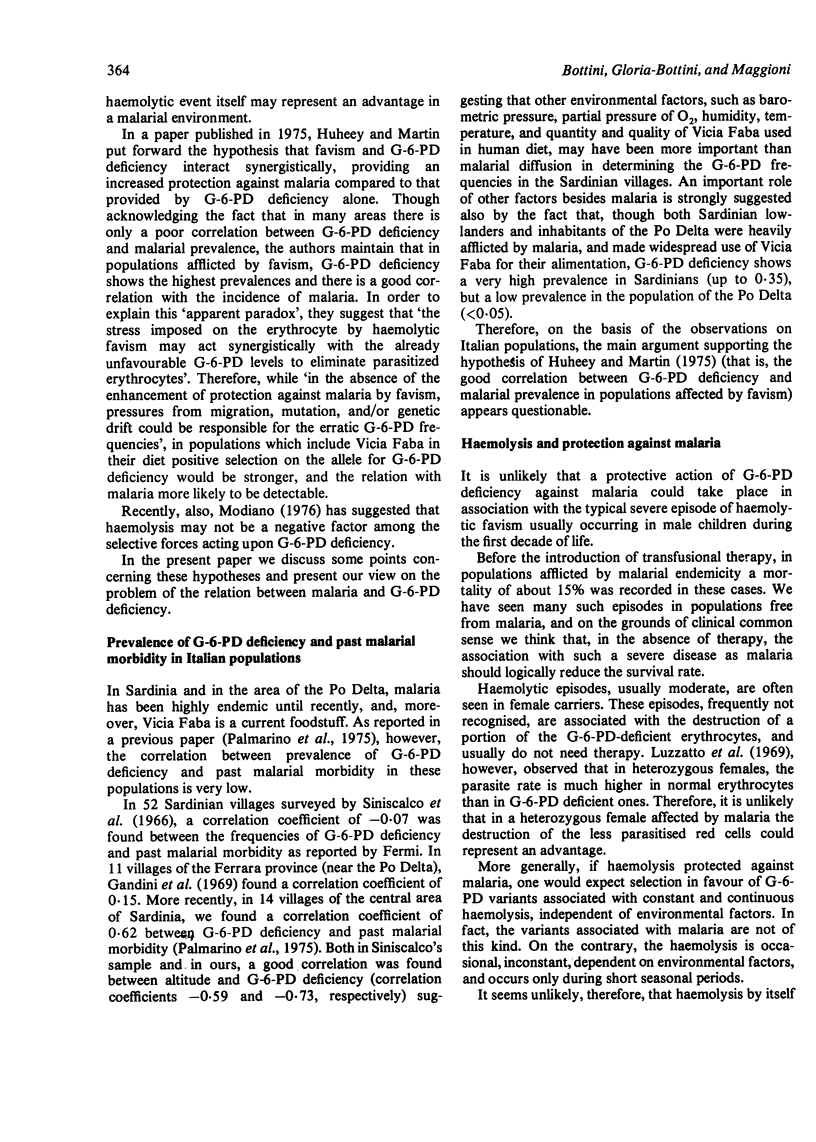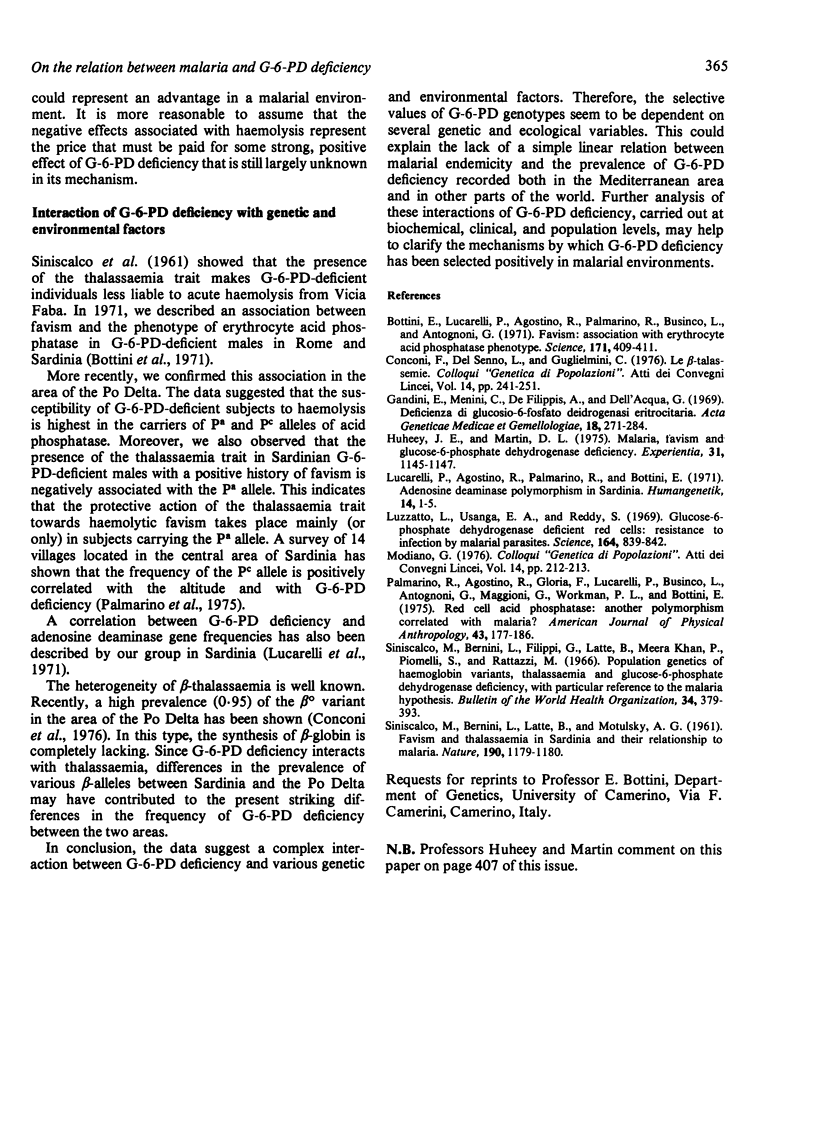Abstract
On the basis of the hypothesis that in the regions where favism is present a high correlation exists between endemic malaria and the frequency of G-6-PD deficiency, Huheey and Martin (1975) in a recent paper suggest that the haemolytic event in a malarial environment is a favourable selective factor. Therefore, the fitness of the G-6-PD-deficient individual who shows haemolysis is higher than that of those who do not show haemolysis. Modiano (1976) also suggested that haemolysis may not be a negative component of the selective forces which act on the G-6-PD-deficient variants.
In this paper, some facts which make these hypotheses unlikely are considered. Other, more promising, lines for the analysis of the complex relation between malaria and G-6-PD deficiency are suggested.
In Sardinia and in the area of the Po Delta, even though favism is present, there is a very low correlation between the frequency of G-6-PD deficiency and past malarial morbidity. Therefore, the situation is similar to that observed in other parts of the world, in which malaria is highly endemic, but where favism is absent.
The following facts seem to be in contrast with the possibility that haemolysis could `by itself' be a favourable event: (1) In the hemizygous male, haemolysis due to favism is generally severe and there is a high mortality rate; (2) In the heterozygous female, the erythrocytes with G-6-PD deficiency seem to show a low parasite rate compared to normal cells, and it is just these erythrocytes that are destroyed during the haemolytic crisis; (3) In malarial environments, enzymopenic variants associated with continuous haemolysis have not been selected. A positive selection of such variants would be expected if haemolysis was `by itself' a positive factor.
Several observations suggest that the G-6-PD system interacts with various factors, both genetical (thalassaemia, erythrocyte acid phosphatase, adenosine deaminase) and environmental (Vicia Faba, altitude, viral and protozoal diseases). In a malarial environment, therefore, the fitness of the different G-6-PD genotypes depends on numerous variables. This could explain the low correlation generally observed between the degree of malarial endemicity and the frequency of G-6-PD deficiency.
Further analysis of the above interactions could elucidate the mechanisms which have brought about the selection of certain types of enzymopenic variants in malarial regions.
Full text
PDF


Selected References
These references are in PubMed. This may not be the complete list of references from this article.
- Bottini E., Lucarelli P., Agostino R., Palmarino R., Businco L., Antognoni G. Favism: association with erythrocyte acid phosphatase phenotype. Science. 1971 Jan 29;171(3969):409–411. doi: 10.1126/science.171.3969.409. [DOI] [PubMed] [Google Scholar]
- Gandini E., Menini C., De Filippis A., Dell'Acqua G. Deficienza di glucosio-6-fosfato deidrogenasi eritrocitaria--studio della distribuzione nella provincia di Ferrara e dei rapporti con malaria e talassemia. Acta Genet Med Gemellol (Roma) 1969 Jul;18(3):271–284. doi: 10.1017/s1120962300011902. [DOI] [PubMed] [Google Scholar]
- Huheey J. E., Martin D. L. Malaria, favism and glucose-6-phosphate dehydrogenase deficiency. Experientia. 1975 Oct 15;31(10):1145–1147. doi: 10.1007/BF02326760. [DOI] [PubMed] [Google Scholar]
- Lucarelli P., Agostino R., Palmarino R., Bottini E. Adenosine deaminase polymorphism in Sardinia. Humangenetik. 1971;14(1):1–5. doi: 10.1007/BF00273025. [DOI] [PubMed] [Google Scholar]
- Luzzatto L., Usanga F. A., Reddy S. Glucose-6-phosphate dehydrogenase deficient red cells: resistance to infection by malarial parasites. Science. 1969 May 16;164(3881):839–842. doi: 10.1126/science.164.3881.839. [DOI] [PubMed] [Google Scholar]
- Palmarino R., Agostino R., Gloria F., Lucarelli P., Businco L., Antognoni G., Maggioni G., Workman P. L., Bottini E. Red cell acid phosphatase: another polymorphism correlated with Malaria? Am J Phys Anthropol. 1975 Sep;43(2):177–186. doi: 10.1002/ajpa.1330430205. [DOI] [PubMed] [Google Scholar]
- Siniscalco M., Bernini L., Filippi G., Latte B., Meera Khan P., Piomelli S., Rattazzi M. Population genetics of haemoglobin variants, thalassaemia and glucose-6-phosphate dehydrogenase deficiency, with particular reference to the malaria hypothesis. Bull World Health Organ. 1966;34(3):379–393. [PMC free article] [PubMed] [Google Scholar]


